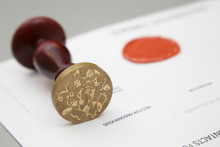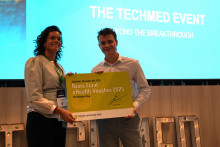To get started in the field, she worked free of charge at commercial photography studios in the region as assistant or stylist - a sort of self-imposed internship. Three years later, after carefully building up a client base, Booijink set out on her own. She began specializing in the public and private welfare sector: Carint, Jarabee, Edith Stein, the municipality of Hengelo.
Commissioned photography pays the bills, but Booijink's true love is art photography, for the freedom it allows. She has exhibited her art photography in Galerie Objektief, Enschede; Galerie Muurbloem, Delden; and, at the Hengelo Rabotheater.
Booijink deems her strongest asset to be her easy contact with people; she likes people and invariably manages to expose their most remarkable facets. She rarely begins a project with a fixed plan, instead taking pictures and deciding later what to do with them, letting intuition lead the way. She suggests that it takes a certain eye to accomplish this, but insists modestly that this way of looking has less to do with talent than with years of practice. For Booijink, the pleasure of photography is in the discovery of subjects. She seeks not perfection in the image, but something which sets the image apart.
Booijink's current UT photography exhibit corresponds to the National Book Week theme: `Mirror of the Lowlands, history of the Netherlands.' Admittedly, she does not find history the most scintillating topic. In order to seek inspiration, she read Jan Wolkers's book on Rembrandt's self-portraits. This led Booijink to a trifold exhibit.
The first part features six large color photos dealing with various aspects of art in the Netherlands. They are printed on canvas, which serves to soften them, rendering a painterly image. The most striking of the set shows a toddler (Booijink's daughter, Rosabé) seated on a Marcel Breuer Wassily B3 chair in the Kröller-Müller museum, with an enormous image of Helene Kröller-Müller in the background. Dutch history comes face to face with its future.
Another group of photos depicts orange objets trouvés that Booijink found around her own house. The orange link to the Book Week theme is obvious, but the photographer herself is an avid fan of the color orange, irregardless of its inherent symbolism in Dutch culture. She displays them as snapshots and they appear on the wall like big orange polka dots.
The final set of prints is a collection of 40 self-portraits, one for each year of Booijink's life. Black and white, sewn onto small ecru drawstring bags - symbolic as repositories for one's personal history - the pictures could have come from anybody's family photo album. They document not only Booijink's history, but that of her generation with barely perceptible clues spotted in clothing and hair style, landmarks, activities. The 40th picture marks the end of an era for Booijink. When she turned 40 last August, she ended her black and white oeuvre, opting instead for color in the next chapter of her career. This exhibit bears testimony to her bold decision: Booijink's personal history is in black and white, her new pieces are in color.
AKI art history professor Elvira van Eijl was on hand to open the exhibit with a few well chosen words. She reminded the audience that art is a vulnerable profession. Photographers hang not just their prized images on the wall, but their ideas, their feelings, their soul as well. While Booijink humbly acknowledges that she hopes people will derive pleasure from her art, if even for a few minutes, van Eijl asserts that looking at photography is an event in and of itself. Each time viewers gaze at a piece of art, the experience marks them indelibly.

Elvira van Eijl opens photography exhibit







